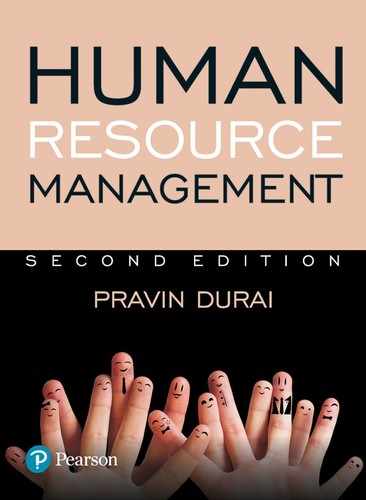APPENDIX F
Competency-Based Pay
Introduction
Competency management has now emerged as one of the key objectives of compensation administration. Competency management has two-fold objectives of (i) attracting, developing, and retaining competent employees and (ii) ensuring high level of performance, loyalty, and commitment from them. When an organization looks for certain essential behaviour among employees, it must be ready to adequately reward such behaviour. In this regard, organizations can use competency framework for defining the behaviour expected from an employee to attain effective job performance. This framework also helps employees to know clearly what is expected of them in terms of behaviour and job role.
An ideal compensation system should not only help an organization to achieve its objectives but also motivate the employees to excel in their roles. Of late, organizations are using competency-based pay system for suitably rewarding the skill and competency of their employees. The purpose behind the development of competency-based system is to define what successful workers are expected to be able to do at each level of their career ladder.1 This competency pay system looks to compensate employees based on their actual capability and the market demand for such capability. According to competency-based system, employees’ values depend on what they can do based on their individual competencies.
Meaning and Types of Competency
A competency is an underlying characteristic of a person (or an organization) which enables him to deliver performance in a given job, role, or a situation.2 Identification of core competencies will enable an organization to decide on its hiring, training, and performance evaluation policies. Competencies required by a firm can be basically classified into threshold competencies—it refers to the characteristics that any job holder should possess for doing the job effectively—and differentiating competencies—it refers to the characteristics that are present only among superior employees and not among average employees. Subject knowledge of a teacher may be viewed as threshold competency, whereas student-centred teaching can be an example for differentiating competencies. In other words, competencies can also be classified as organizational competencies, job-related competencies, and personal competencies. Let us see them briefly.
Organizational competencies are those distinct factors that make an organization competitive. Job-related competencies are the competencies that are essential for effective performance of the job. Personal competencies are the competencies of individual employees necessary for fulfilling or even exceeding the job expectations of the organization. The personal competencies usually include the following four behavioural competencies:
- Personal competencies (e.g., self-development, taking initiatives, exhibiting loyalty, and delivering results)
- Interpersonal competencies (e.g., relationship building, team building, and openness)
- Information-oriented competencies (e.g., creating and conceptualizing, analysing and interpreting, and strategizing)
- People management competencies (e.g., organizing and executing, leadership and motivation, and knowledge sharing)
Steps in Developing a Competency-based Pay System
Even though competency is required for every job and for every employee, competency-based pay is not widely used for compensation management. In fact, this type of pay system is implemented in a few organizations only. As seen in Figure F.1, the basic steps involved in the preparation of competency-based pay system are as follows:
- Creating a competency model
- Developing competency mapping
- Connecting competencies with compensation factors.
We shall now briefly discuss each of these steps.
- Creating a competency model: A competency model is a collection of competencies that together define successful performance in a particular work setting.3 The competency model is an essential requirement for developing competency-based pay system. Based on its relative importance in the work setting, each competency can be quantified, and this serves as a reference for all competency-based compensation management activities. Generally, competency models are organization specific as the characteristics and requirements of each business is unique.

Figure F.1
Preparation of Competency-based Pay System
- 2. Developing competency mapping: Once competency model is developed, then competency mapping process has to be carried out. Competency map is an evaluation tool useful in determining employees’ strengths and weaknesses, thereby serving as a template for formulating performance growth and development plans4 and also for compensation fixation. Competency mapping involves identification of key attributes (e.g., Knowledge, skill, and behaviour) that are needed by employees for effective performance of their jobs. Generally, competency mapping is a quite complex process as it should reflect all knowledge, skill, and attitudes of employees used to achieve performance targets. Competencies of the employees can be mapped (or rated) by themselves, their superiors, and even peers. Certainly, it helps individuals to better understand themselves and determine the goal and direction of their career development efforts.
- 3. Connecting competencies with compensation factors: The next step in the competency-based pay is to connect the employee pay with his competency mapping ratings. Organizations can compute the ‘compensation factor’ based on the weighted average of the competency ratings obtained by an employee. Compensation factor then become the basis for designing compensation strategies of an organization. However, the compensation strategies may differ from one organization to another due to differences in their compensation policies and practices.
Organizations, which aim to achieve higher rate of growth, need to pay attention to this very vital aspect of employee motivation. Compensation-based pay is capable of taking care of quality of life of employees and asset building and social status needs of organizations.
Notes
- David Allen Baldwin, The Library Compensation Handbook: A Guide for Administrators, Librarians and staff, (Westport, CT: Libraries Unlimited, 2003) p. 174.
- Nick Boulter, People and Competencies (London: Kogan Page, 1996).
- Donald L. Grove, The Essential Guide to Getting a Job in the Nuclear Power Industry: How to Secure Full Time Employment or Contract Work, (Florida, USA: Universal Publishers, 2014) p. 157.
- Jerry W. Gilley and Ann Maycunich Gilley, The Manager as Coach, (West Port, CT: Praeger Publishers, 2007) p. 69.
